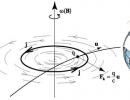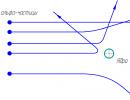Child psychology and obtaining practical skills. Children's practical psychology Children's practical psychology
Hall expressed the idea of creating practical child psychology that was in the air, combining the requirements of pedagogical practice with the achievements of contemporary biology and psychology. The pioneers of pedology were doctors and biologists, since at that time it was they who owned big amount objective methods for studying children, and psychology has not yet developed these methods. However, over time, it was the psychological side of research that came to the fore, and gradually, starting in the 20s. century, pedology began to acquire a pronounced psychological orientation. The popularity of pedology led to the development of a mass pedological movement not only in America, but also in Europe, where its initiators were such famous scientists as E. Maiman, D. Selley, V. Stern, E. Claparède and others.
The works of D. Selley “Essays on the Psychology of Childhood” (1895) and “Educational Psychology” (1894-1915) contributed to the penetration of psychological ideas into educational institutions, a partial change in training programs and the style of communication between teachers and children. His works had great importance for the development of practical child psychology and pedology, since Selly studied what associations and in what order appear in the process mental development children. His research showed that the first associations are those of similarity, then gradually children form images of objects based on associations of contiguity, and at the end of the second year of life associations of contrast arise. The data obtained by Selley also made it possible to identify the main stages in cognitive, emotional and volitional development children that need to be taken into account when teaching them.
Based on these provisions, Selli’s follower, M. Montessori, developed a system of exercises that promote the intellectual development of children preschool age. The basis of this system, which is quite widespread today, is the training of sensations as the main elements of thinking, the awareness and integration of which contributes to cognitive development children.
The German psychologist and teacher E. Maimann founded a psychological laboratory at the University of Hamburg, which conducted research on the mental development of children. Meiman also became the founder of the first special journal devoted to pedological problems, the “Journal of educational psychology" He paid main attention to the applied aspect of child psychology and pedology, since he believed that the main task of pedology is to develop methodological foundations teaching children. His three-volume “Lectures on Experimental Pedagogy” (1907) was a kind of encyclopedia of educational and practical psychology of that time.
Meiman believed that pedology should not only study the stages and age characteristics mental development, but also to explore individual development options and diagnose it. At the same time, training and education should be based both on knowledge of general patterns and on an understanding of the characteristics of the psyche of a particular child.
An experimental school was organized at Meiman's laboratory, which existed for more than twenty years. It tested different programs for teaching children, developed taking into account Meiman's periodization, and also explored various ways of selecting children into classes based on their preliminary diagnosis. At the same time, different selection criteria were experimentally studied - according to the level of intelligence, according to the interests and inclinations of the children, as well as according to the style of communication with the teacher that is adequate for them. It is necessary to note that if giftedness, as well as the cognitive interests of children, were taken into account to one degree or another before, then the problem of interaction between teacher and students and the reaction of students to different styles of communication was first posed with such completeness by Meiman.
The Swiss psychologist E. Claparède played a major role in the development of practical child psychology. He founded the association applied psychology And Pedagogical Institute them. J.J. Rousseau in Geneva, which became an international center experimental research in the field of child psychology.
Claparède proposed dividing child psychology into applied and theoretical, since, in his opinion, they have a different range of problems studied. He considered the task of theoretical child psychology to be the study of the laws of mental life and the stages of mental development of children. At the same time, he divided applied child psychology into psychognostics and psychotechnics. Psychognostics was aimed at diagnostics and measuring the mental development of children, and psychotechnics was aimed at developing methods of teaching and upbringing that were adequate for children of a certain age.
Thus, Claparède laid the foundations for an independent branch of psychological science - practical child psychology, having a significant influence on the understanding of the range of problems it solves and its tasks.
The development of practical child psychology and pedology required not only a clear definition of the subject and tasks of this science, which was done by Meiman and Claparède, but also the development of new objective methods of mental development of children, which in their reliability and objectivity would not be inferior to the natural sciences (for example, anthropometry). One of the first to search for such new ways of measuring mental qualities was the English scientist F. Galton.
While doing experimental psychological research (studying sensitivity thresholds, reaction time, associations and others mental processes), Galton paid main attention not to the laws common to all individuals, but to their variability among different people. He invented a number of special techniques for studying this variability, which became the source of a new major branch of psychology - differential psychology. Having emerged in the depths of experimental psychology, it acquired independent theoretical and practical significance. Particularly significant was the introduction into psychology of new mathematical methods, mainly statistical.
In studying the question of the origin of mental qualities, Galton used questionnaires along with the biographical method. He sent out a detailed questionnaire to major scientists, based on the materials of which the monograph “ English people sciences: their nature and nurture" (1874). A decisive role in the development of abilities to scientific activity he attributed it to heredity, but considered the influence of external conditions and upbringing to be insignificant, and sometimes even negative.
Later, Galton added an experiment to the study of individual differences through questionnaires. At the international exhibition in London in 1884, Galton organized a special laboratory for this purpose. Over 9 thousand subjects passed through it, and along with physical (height, weight) and mental indicators (various types of sensitivity, reaction time, etc.) were measured.
Galton is the author of many specific methods both diagnosing various signs and establishing correlations between them. The method for calculating correlations between variables has significantly enriched psychological science, became a prerequisite for the development of one of the most important psychological methods - factor analysis. Among Galton's achievements, special mention should be made of the development of test methods. The test (test) became one of the most important techniques in Galton’s laboratory and subsequently became firmly established in science. Statistical approach - applying a series of tests to a large number individuals - was put forward as a means of introducing precise quantitative methods into psychology. It got big practical use, and the further improvement of the technology for developing and using tests, their extension to the study of the most important psychological parameters (memory, thinking, personality) essentially changed the general appearance of psychological science.
The term “test,” as well as these tests themselves, developed by Galton, became widely used in psychology after the article by the American psychologist D. Cattell “Mental Tests and Measurements,” published in 1890 in the journal Mind. with an afterword by Galton. Cattell believed that statistical method, the application of a series of tests to a large number of subjects, is a means of transforming psychology into an exact science. However, he attached no less importance to the practical value of tests, which could become the basis of a new, practical psychology. The task of this psychology is to develop exercises that are adequate for each person, allowing them to overcome shortcomings or deviations in the development of certain mental qualities, diagnose diseases, and also form an individual lifestyle.
Understanding the shortcomings of his contemporary test system, in which almost any short-term test could qualify for this title, Cattell emphasized that in order to increase the validity and value of tests, it was necessary to develop a uniform system so that “determinations obtained at different times and in different places can be was to compare and unite.” He proposed 50 tests as a sample, including various types of measurements of sensitivity, reaction time, different types memory. Cattell used this test system in the psychological laboratory he organized at Columbia University in 1891. The success of this work led to the fact that in a short period of time most American psychological laboratories began to use various tests, and soon this method actually eclipsed all others. The variety of tests, as well as the lack of clear criteria for their use and evaluation, led to the fact that in the mid-90s. There was a need to organize special centers that coordinated the work of individual laboratories. In 1895-1896 In the United States, two national committees were created that united the efforts of the scientists who developed the tests, giving a general direction to their work.
Year of issue: 2004
Genre: Psychology
Format: PDF
Quality: eBook (originally computer)
Description: This book contains the material necessary for the work of practical psychologists in preschool educational institutions. It reflects different aspects of a psychologist’s work related to diagnostics and correction of children’s mental development, communication with teachers and parents, preparation of documentation and the psychologist’s workplace.
Separate chapters are devoted to the history of practical child psychology, a description of the main directions in the activities of a practical psychologist, and documents regulating his status. Revealed general patterns mental development of children in the first years of life, describes approaches to diagnostic and correctional work with children and parents, ways to incorporate materials obtained during diagnosis into the practice of correctional work are shown. Much attention is paid to familiarizing readers with the problem of deprivation and its consequences for children, as well as describing games and exercises that make it possible to overcome some developmental disorders cognitive processes and children's communication.
At the end of each chapter, readers are invited to answer questions and complete tasks that will help test themselves and transfer the learned material into practical activities.
The book includes a list of references and a glossary of terms. The appendices provide samples of documentation from a practical psychologist, as well as materials that will help in working with children - sets of techniques for of different ages, methods of their application and interpretation of the data obtained, as well as samples of diagnostics, correctional classes, conversations with parents.
The textbook is intended for students of psychological and pedagogical universities and colleges, as well as for practical psychologists working in educational institutions.
Chapter 1. History of practical child psychology
1.1. The formation of practical child psychology and pedology
1.2. The formation of practical child psychology in Russia
1.3. Development of practical psychology and pedology in the 20-30s
Questions and tasks
Chapter 2. Organization of psychological services in a preschool institution
2.1. Psychological office
2.2. Psychological tools
2.3. Normative documents child practical psychologist
2.4. Special documentation
2.5. Organizational and methodological documentation
Questions and tasks
Chapter 3. Features of mental development of preschool children
3.1. Mental characteristics of children during the neonatal period and infancy
3.2. Mental characteristics of young children
3.3.Features of mental development in preschool age
3.4. General approaches to diagnosing the mental development of children
Questions and tasks
Chapter 4. Directions professional activity practical psychologist in a preschool setting
2.1. Psychodiagnostics
4.2. Psychocorrection and psychoprophylaxis of deviations and disorders in child development
4.3. Psychological counseling and education
4.4. Psychological support of the pedagogical process
Questions and tasks
Chapter 5. Mental deprivation and its impact on the development of children in the first years of life
5.1. Terminology
5.2. Features of deprivation of mental development in infancy
5.3. Features of deprivation of mental development at an early age
5.4. Features of deprivation of mental development in preschool age
Questions and tasks
Chapter 6. Corrective games and activities for children with communication difficulties
Questions and tasks
Perm State Pedagogical University
Children's practical psychology
Compiled by: Lyadova K.V.
Perm, 2009
The formation of practical child psychology abroad and in Russia
The origin and development of practical child psychology at the end of the 19th and beginning of the 20th centuries. was closely related to pedology, the science of children created by the American psychologist Grenville Stanley Hall. Hall was a student of W. Wundt. In 1883, Hall organized the first experimental laboratory in the United States at the University of Baltimore, in which the study of the mental development of children, mainly adolescents, began. Hall was one of the first to draw attention to the importance of practical study of the process of development of the psyche of a particular child. One of the main goals of pedology, according to Hall, was the development of recommendations for parents and teachers on teaching and raising a child. Hall expressed the idea of creating practical psychology that was in the air, combining the requirements of pedagogical practice with the achievements of contemporary biology and psychology. However, over time, it was the psychological side of research that came to the fore, and gradually, starting in the 20s. XX century, pedology began to acquire a pronounced psychological orientation. The popularity of pedology led to the development of a mass pedological movement not only in America, but also in Europe, where its initiators were such famous scientists as E. Maiman, D. Celi, V. Stern, E. Claparède and others.
The works of D. Selie “Essays on the Psychology of Childhood” (1895) and “Pedological Psychology” (1894-1915) were of great importance for the development of practical child psychology and pedology, since he studied what associations and in what order appear in the process mental development of children. The data obtained by D. Seli also made it possible to identify the main stages in the cognitive, emotional and volitional development of children, which must be taken into account when teaching them. Based on these provisions, M. Montessori developed a system of exercises that promote the intellectual development of preschool children. The German psychologist and pedologist E. Meimann founded a psychological laboratory at the University of Hamburg, which conducted research on the mental development of children. Meiman also became the founder of the first special journal devoted to pedological problems, the Journal of Educational Psychology. He believed that pedology should study not only the stages and age-related characteristics of mental development, but also explore individual development options and carry out its diagnosis. At the same time, training and upbringing should be based both on knowledge of general patterns and on understanding the characteristics of the psyche of a particular child.
The Swiss psychologist E. Claparède played a major role in the development of practical child psychology. He founded the Association of Applied Psychology and the Pedagogical Institute. J.J. Rousseau in Geneva, which became an international center for experimental research in the field of child psychology. Claparède proposed dividing child psychology into applied and theoretical. He considered the task of theoretical child psychology to be the study of the laws of mental life and the stages of mental development of children. At the same time, he divided applied child psychology into psychodiagnostics and psychotechnics. Psychodiagnostics had the goal of diagnosing and measuring the mental development of children, and psychotechnics was aimed at developing teaching and upbringing methods adequate for children of a certain age. The English scientist F. Galton was one of the first to begin the search for new ways to measure the mental development of children. He paid main attention not to the laws common to all individuals, but to their variability among different people. He invented a number of special techniques for studying this variability, which became the source of a new major branch of psychology - differential psychology. Particularly significant was the introduction of new mathematical methods, mainly statistical ones, into psychology. Among Galton's achievements, special mention should be made of the development of the test method. The test became one of the most important techniques in Galton's laboratory and subsequently became firmly established in science.
The French scientist A. Binet was one of the first to develop methods that make it possible to quickly and reliably determine the level of intelligence of children and differentiate between normal and abnormal children. Created tests for diagnosing intellectual development in children from 3 to 18 years old.
In Russia, DPP began to develop at the beginning of the twentieth century in close combination with pedology. The true initiators of the formation of pedology in Russia were A.P. Nechaev, N.P. Rumyantsev and V.M. Bekhterev.
In the fall of 1904, the first courses in Russia opened in St. Petersburg under the leadership of Nechaev. The purpose of these courses was to disseminate the knowledge necessary to understand the mental and physiological characteristics of childhood and adolescence, as well as to increase the theoretical potential of teachers.
One of the main tasks facing the DPP at that time was the search for objective methods for studying and diagnosing the psyche. Tests, questionnaires, biographical, statistical and anthropometric methods were used. For an experimental study of children in 1905 A.F. Lazursky together with A.P. Nechaev created the first psychological laboratory in St. Petersburg. Lazursky’s joint work with the famous psychologist and philosopher S.L. Frank brought him to the idea of two spheres of mental activity – endopsychic (internal) and exopsychic (external). Based on the level of development of various endo- and exogenous factors, Lazursky developed the first personality typology, as well as a system for diagnosing and correcting various types of deviations in the process of a child’s mental development.
Research on the mental development of a child has led many scientists to the idea of the importance of family and family climate in this process. Therefore, systematic education of parents began. For this purpose, Parent circles were organized, books on family education were published, in particular by P.F. Kapterev organized the publication of a series of brochures on the problems of family education and training. I.A. paid great attention to the study of children’s mental development. Sikorsky. In his works, he explored the role of affects in the development of deviations and defects in the mental development of children, and also developed recommendations for their correction. He was one of the first to draw attention to the role of fatigue in reducing children's academic performance and developed methods to reduce it. He was the first to organize the Frebel Center in Kyiv, at which there was an experimental school and psychological consultation. Thus, future teachers not only received theoretical knowledge in psychology, but also tested them in practice. After 1917, leading scientists did not emigrate from the country. They set new tasks - the development of a harmonious personality within the framework of Marxist theory. A.B. saw this as their goal. Zalkind, P.P. Blonsky, K.N. Kornilov, M.Ya. Basov, L.S. Vygotsky et al.
Early 20s was associated with the emergence of the modern school and the formation of more effective teaching methods. This required an in-depth study of the personality of each child. Therefore, methods taken from foreign psychology were used, and there were attempts to use both new and old diagnostic tools. Various institutions were organized. In 1918, the Children's Research Institute named after A.I. was organized at the Psychoneurological Academy. A.S. Griboyedov, the second major psychological center in Leningrad was the Pedagogical Institute named after. A.I. Herzen. At the Academy of Communist Education named after. N.K. Krupskaya's psychological research was carried out by employees of the Office of School Pedology under the leadership of Blonsky.
Anthropometric data of children were studied, characteristics of a preschool child were compiled, and the child’s mental development was measured. The results obtained were processed using elementary statistical techniques. Teachers in schools also had to be able to diagnose.
Since the 30s. A threat looms over the DPP, associated with both subjective and objective reasons. Subjective - changing social conditions: what was required was not an individual approach, but an executive worker. Objective – the use of unadapted techniques leading to errors; lack of qualified personnel in the workplace. All this led to the appearance of the famous decree of 1936 “On pedological perversions in the NARKOMPROS system” and the directive closure of pedology as a science in general.
Thus, several stages can be distinguished in the development of practical child psychology and pedology in Russia.
Stage I (1900 – 1907) – the emergence of DPP and pedology, the emergence of the first theories and studies of the mental development of children, the organization of courses and experimental laboratories, the beginning of publication of the first journals and books on DPP.
Stage II (1908 – 1917) – development of methodological principles for constructing DPP and pedology in Russia, the emergence of the first psychological centers connecting theoretical and experimental (diagnostic) activities.
Stage III (1918 – 1924) – the period of formation of the Soviet DPP, the revision of the old empirical, pre-October science. This is happening against the backdrop of the general rise and diversity of the country’s cultural life.
Stage IV (1925 – 1928) – a period of consolidation of different groups and movements in child development and pedology, development of a unified platform for science aimed at the comprehensive study and development of the child’s personality. At this time, the connection between psychological theory and practice is strengthened, and specific tasks are set for the development and improvement of work in schools and kindergartens.
Stage V (1929 – 1931) – a period of intensive development of DPP and pedology, the emergence of theories revealing the patterns and mechanisms of mental development (M.Ya. Basov, L.S. Vygotsky). However, during the same period, attacks on the DPP began, associated with changes in the social situation in society, the introduction of uniformity and authoritarianism in school life. The gap between theory and practice, which had not been fully bridged in previous years, is beginning to widen again.
Stage VI (1932 – 1936) – during this period, the formation of a totalitarian state, permeated with a rigid hierarchical system of relations between people, ends. The elimination of interest in the child’s personality and creativity in school and public practice led to an even greater separation of psychological theory from practice. Attacks on pedology and accusations of ignoring school requirements are intensifying. This criticism of both real and pedologically imposed errors led to a 1936 decree that practically banned DPP in Russia.
Currently, the domestic DPP is experiencing new stage, in which practical and theoretical problems are closely intertwined. The need to attract psychologists to work in educational institutions has once again emerged, thanks to the efforts of many scientists, primarily I.V. Dubrovina and her laboratory (in the 80s), the foundations of practical psychological service were developed.
In 1988, a decree was issued on the organization of psychological services in schools, then in kindergartens, and in 1989 a regulation on this was issued.
Literature
1. Practical child psychology / Ed. T.D. Martsinkovskaya, - M., 2004. Psychological service in the education system: its necessity, structure, tasks.
Ethics of psychological work
1) Psychological service is an organizational structure that includes educational psychologists of educational institutions of all types, educational institutions for children in need of psychological, pedagogical and medical-social assistance (PPMS - centers), psychological, pedagogical and medical-pedagogical commissions (PMPC), scientific institutions, departments of higher educational institutions, educational and methodological classrooms and centers of educational authorities and other institutions that provide assistance to participants in the educational process. garden. Operating Guide practical psychologistPractical work >> Psychology
AND WENGER CHILDREN'S CENTER Psychologist V children's Garden Work Guide practical psychologist Authors: L.A. WENGER, E.L. ... V.V. KHOMOVSKAYA, L.I. TSEKHANSKAYA. Tasks and functions psychologist V children's garden Psychologist V children's garden is, first of all, a knower...
Children's fears and anxieties
Abstract >> PsychologyFinally, the results of the study showed that practically all subjects with a low level of anxiety... - value attitude for children 5-9 years old // Children's practical psychologist. - July. – 2005. Parishioner A. M. Causes, prevention...
Psychologist Eternal characteristics of children with delays in mental development
Thesis >> PsychologyIn development. Ed. M. S. Pevzner. M., 1996. Children's practical psychology: Textbook. / Ed. T.D.Martsinkovskaya. – M.: Gardariki... children's development. - M., 2007. Nikishina V.B. Practical psychology in working with children with mental retardation...
Psychologist Eternal characteristics and psychosomatic disorders during the newborn period
Coursework >> PsychologyIn development. Ed. M. S. Pevzner. M., 1966. Children's practical psychology: Textbook. / Ed. T.D.Martsinkovskaya. – M.: Gardariki... development. - Defectology, 1977, No. 6. Obukhova L.F. Children's psychology: theories, facts, problems. M., 1995. Workshop...
In accordance with the state educational standard higher vocational education the second generation examines the history of practical child psychology, the organization of psychological services in a preschool institution, and the features of the mental development of preschool children. Various aspects of the work of child psychologists are reflected: diagnosis and correction of the mental development of children, treatment of teachers and parents, preparation of documentation and the workplace. For students of higher educational institutions studying in the areas and specialties "Psychology", "Pedagogy", "Preschool Pedagogy and Psychology", "Pedagogy and Methods preschool education", "Special preschool pedagogy and psychology". Of interest to practical psychologists working in educational institutions.
On our website you can download the book "Children's Practical Psychology" Martsinkovskaya Tatyana Davidovna for free and without registration in doc format, read the book online or buy the book in the online store.
Today, the study of child psychology is quite dynamic, and the demand for this area is constantly growing. Interest in this branch of science is very great and not accidental. Modern society increasingly realizes the value of a person as an individual, pays tribute to the knowledge of the potential of creative activity. Development emotional state, defining oneself and feeling in the world is often the goal that justifies existence. Raising a developed, creative and free thinking man- the responsibility of not only parents, but also teachers.
Why is practical child psychology needed?
People who work with children observe them daily. This gives them the opportunity to notice some behavioral features in different situations, promptly pay attention to emerging mental difficulties, which is especially important today, since more and more children have serious deviations in the perception of the world around them. It is very difficult to identify them in a timely manner and to react adequately without having certain knowledge. A teacher, as part of his activities, very often must act as a psychologist. And having the skills, as well as knowledge of the basics of practical child psychology, which you can talk about, is very important and necessary!
Purpose of study
The functions, tasks and methods of a psychologist, educator, teacher are very different. But they have one thing in common: a child. Therefore, their common goal is to surround the pupil with emotional well-being, psychological security and established social contacts. To create an aura of comfort for little man, you need to know the answers to many questions. Why and what are the differences between people? How are temperament types manifested? What are the body features, which ones are normal and which ones are not? What causes children’s interest in their genitals, and how to react correctly to its manifestation? Is it capable of influencing environment on the development and change of the psyche?
The need for knowledge
The ability to apply psychological skills is the path to one’s own harmonious coexistence with the outside world and a tool for helping others. Obtaining such knowledge is not a problem today. It is enough to have a desire! The part-time education system is very convenient for final-year students and for those who are already working but want to acquire an additional profession or improve their skills.
Upon completion of the course, students have the right to fully realize their research interests; they successfully apply the acquired skills in pedagogy, sociology, psychology, pediatrics, biology, and anthropology. No matter how mature and wise people are, sometimes they need the help of a specialist, especially when it comes to the health of children, their upbringing and development.
When parents’ emotions take precedence over reasonable arguments, when an objective assessment and an independent look at the “father-child” relationship is needed, in order to understand the situation that complicates the child’s life, the skills acquired while taking a course in child practical psychology will come in handy.






